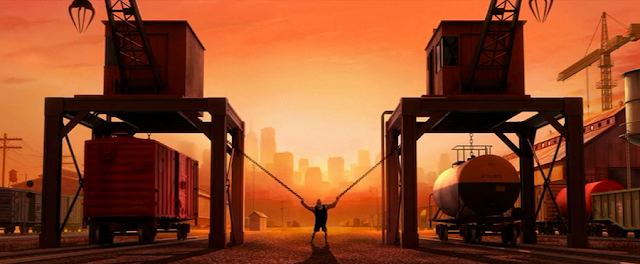I consider Extreme Wide Shots, Long Shots, and Full shots to all be "wide shots".
They used wide shots through out the film to help establish or re-establish the location the characters were in. The closer you go in on a character the more clearly you can see what they are doing, and how they are interacting with their environment or other characters.
Medium Shot
Medium Shots are widely used through out the film, they are a reliable standard to show you the character nice and close, but not too close, usually cutoff at the waist, plenty of empty space is left around the character, giving him room to act out, gesture, and still see the character in relation to the environment he's in. It's not too intimate, but it's showing you something specific.
There are slight variation like the Medium-Full Shot, where the characters are cut off around the knees.
Close-up Shot
The close-up is usually the full head and sometimes a bit of the top is cropped off, and includes the neck and a bit of the shoulders. It's an emotion-teller and and information-giver. This shot is ALL about the subject, it tells us the important stuff we need to know to understand the story. We can tell what the character is feeling and thinking.
There are variations on these too, like the Medium Close-Up, which crops the character off somewhere between the ribs and the chest.
The closer you frame your main subject the more it becomes all about them. The background gets phased out as the focus closes in on the character or object you are centering on.
Extreme Close-up
It can be used for a very intense or super intimate moment or it can just be a very useful information tool. It depends what the director wants to show you and why. In this shot, nothing else matters but the subject matter. And it's usually only a portion of that subject matter. Backgrounds are usually unrecognizable, you can only see the character or object as they cover most (if not all) the frame. It keeps the audience informed about the story, the characters and the situation, up close, in detail, clear information-giver.
There's not much room for the character to move, so the audience can focus on the expressions and emotions. You can call this a "cut-in" also, instead of zooming in, you cut the camera in closer, or to a different part of the body to show something important.
Depending on what the director wants to show the audience, every type of shot has it's purpose, how the filmmakers decide how close or wide to frame a scene, depends on what they want the focus to be and what information they are trying to display.
Let's have a quick look at camera angles...
Straight-On
The camera is level to the ground and the lens is lined up parallel to the main subject.
Up Shot
The camera is pointing up at the subject.
This is called a 'Low Angle' in live action.
Down Shot
The camera is angled to point downwards towards the subject.
This is called a 'High Angle' in live action.
Up Shots place the viewer beneath the focus and Down Shots
place the viewer above, both physically and psychologically.
I'll talk a lot more about this later.
Bird's Eye View
Worm's Eye View
More extreme version of up shots and down shots where the angle
of the camera is pointing nearly (or entirely) straight up or down.
Over The Shoulder Shot
(OTS) One of the most efficient and widely used methods of shooting a conversation scene, or even to see the vantage point of one character as s/he glares at another. Sometimes the characters are in close proximity, sometimes they are far away, the shots reverse back and forth and can be used in combination with up shots and down shots, depending on the camera angle and height or placement of characters.
1 Shot
2 Shot
3 Shot
Group Shot
These are pretty self-explanatory, 1 shot: one subject in the frame. 2 shot: there's two, when you get more than 3 in there, you've got a group shot.
There are endless combination that can be used to describe a shot.
Here's a 2 Shot, Medium Shot, and a slight Up Shot all rolled into one.
Low Angles
When the camera is sitting right on the ground.
Each angle and framing technique and the combination they are used in - can all help to tell the story and to clearly display the information on screen so that the audience can follow along easily. Variety of shots is important, but as I will show you, the Incredibles excelled at using dynamic angles and perspective to make the film very visually exciting. I've noticed that different film theory books have slightly different terms for this sort of thing. My terms here are more akin to Animation Filmmaking, some studios and directors have variations on these as well.
Point of View (POV)
This shot places the audience in the character's shoes, seeing the world through their eyes.
Rack Focus
Shifting the attention of the viewer by changing the focus of the lens from a subject in the foreground to a subject in the background (or vice versa).
Summary for Framing Shots


Summary for Camera Moves in 2D Animation

















































































